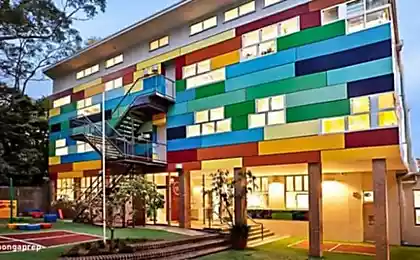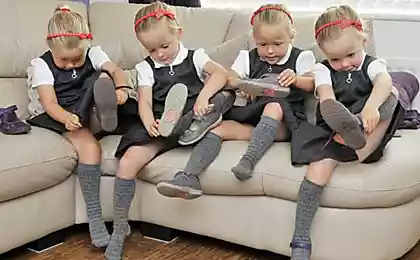638
The owners of companies-the giants of Silicon Valley send their children to school without computers

Technical Director eBay sent their children to a school located in Los Altos, California.
So did the staff and other giants of Silicon valley: Google, Apple, Yahoo, Hewlett-Packard.
However, to study in this school used the familiar, not associated with the latest technologies, tools:
pens, pencils, sewing needles, sometimes even clay, etc.
And no computer. None of the screen.
Their use is prohibited in the classroom and not encouraged at home.Across the country, schools are rushing to equip their classrooms with computers, and many politicians claim that not to do so is just silly.
However, the opposite point of view is widespread in the midst of a high-tech economy, where some parents and teachers make it clear:
school computers are not compatible.
We are talking about the Waldorf School of the Peninsula, one of 160 Waldorf schools in the country that adhere to the philosophy of learning through physical activity and creative tasks.
Those who use this approach believe that computers inhibit creative thinking, movement, human interaction and attention.
Waldorf pedagogy for almost a hundred years, but its distribution here in the epicenter of digital development, has generated considerable debate about the role of computers in education.
"I completely deny the idea that using the computer in elementary school," says Alan Eagle, 50, whose daughter, Andie, is one of 196 students of Waldorf elementary school.
His son William, 13 years old, studying at a nearby secondary school.
"The idea that the iPad can better teach my kids to write or to count, ridiculous."
Mr. Eagle on the short leg with the technology.
He holds a degree in computer science from the University of Dartmouth, and works at Google, where he writes speeches for CEO Eric Schmidt.
He has an iPad and a smartphone.
But he claims that his daughter, a fifth-grader, "doesn't know how to use Google", and the son is just learning how to do it.
(Since eighth grade, the school allowed limited use of electronic devices.)
The majority of parents of students are directly related to high technology.Mr. Eagle, like other parents, sees no contradiction in this.
"Technology has its time and place, he says. — If I worked on the Studio Miramax and made a great movie for adults, I would not want my children watched them before they turn 17".
While other schools in the region are proud of their rich classrooms,
Waldorf school has a very simple old-fashioned kind – Board with colored chalk, bookshelves with encyclopedias, wooden desks with notebooks and pencils.

Last Tuesday in the 5th grade, Andie Eagle and her classmates knitted on wooden needles small samples of wool, restoring the skills of knitting, obtained in the lower grades. This activity, according to the school,
helps to develop the ability to solve complex problems, to structure information, to count, but also develops coordination.
But the ultimate goal: to knit socks.
In 3rd grade the teacher taught students to multiply, asking them to be fast as lightning.
She asked them the question, how much is four times five, and they all together shouted "20" and flashed his fingers, bringing the right number on the Board.
A room full of living calculators.
Second grade, standing in a circle, repeated for a teacher poem, while playing with a sack filled with beans.
The purpose of this exercise is to synchronize the body and brain.
Here, as in other classes, the day can begin with a poem about God, talking about the Divine without regard to any denomination.
Andy's teacher, Cathy Waheed, a former computer engineer, tries to make the process of learning and practical experience to the fingertips.
Last year the children learned fractions by cutting different foods ( apples, cakes ) in half: half, quarter, and sixteenth.
"Within three weeks we were "eaten" our way to understanding fractions", — says the teacher.
"What do you think, could I hold their attention until the cake was cut so as to have enough for the piece at all?"
Some experts believe that the desire to equip classrooms with computers is unwarranted, since there is no accurate evidence that computers improve academic performance.
Does learning through the division of the pie and knitting the best results? It is quite difficult to compare, partly because as private schools, Waldorf schools do not conduct standard checks in Junior high.
Supporters of the Waldorf method is the first to say that their younger students may not show good results because they are not coached on standard math and reading.
When talking about the effectiveness of Waldorf education, representatives of the Association of Waldorf schools of North America refer to a study according to which 94 % of the graduates of Waldorf schools in 1994-2004 enrolled in colleges, including such prestigious institutions like Oberlin, Berkeley and Vassar.
In these figures it is not surprising, given that we are talking about students who highly valued education, and parents looking for their children to special private schools and have the ability to pay for them.
It is very difficult to assess for himself the method of "low-tech" learning without considering other factors.
For example, parents of students of Waldorf school in Los Altos say that in this school, you get good teachers,
who have undergone serious training in the Waldorf method.
This fact unites them in the creative circle of like-minded people, which other schools may not be.
Since there is no single proven theory, the conversation boils down to subjective judgment and parental choice, based on different understanding of concepts such as:
- the involvement of children in the educational process
- the desire to acquire knowledge
- a revival of interest in learning
computers help to keep the attention of the student, make learning easier
and that children who grew up with computers and other technological devices
can't live without to concentrate and hold interest.
According to Ann Flynn, Director of educational technology National Council for education, computers are needed.
"If schools have access to new technologies and can afford them, but do not use them, they deprive our children of what they can be worthy," said Flynn.
Paul Thomas, former teacher and University Professor Furman, who wrote 12 books about educational practices in public institutions,
don agrees with her, arguing that the educational process better if computers use as little as possible.
"Education is first and foremost a human experience, gain experience — says Paul Thomas. – Technology is only a distraction when we need literacy, numeracy and the ability to think critically".
And the parents of Waldorf students claim to hold the child's attention can only be a real teacher with interesting lesson plan.
"Involvement in the educational process is first of all human contact, the contact to the tutor, with peers," says Pierre Laurent, 50, a former employee of Intel and Microsoft.
His three children enrolled in Waldorf school, and his wife Monica so imbued with the Waldorf system of education that in 2006 she went to work as a teacher.
When supporters of equipping the classes with computers declare that computer literacy is necessary to confront the challenges of modernity, Waldorf parents wonder: why the rush if it's all so easy to master?
"It's super easy. This is about the same as learning to brush teeth, says Mr. Eagle. On Google and such places, we make technology as stupidly simple as possible. I see no reason to believe that the child will not be able to master them when you get older."
In Waldorf schools in San Francisco, in Greenwood in mill valley a lot of the children whose parents are close to production of high technologies.

In California 40 Waldorf schools – quite a lot probably due to the fact that the spread of Waldorf education started here, said Lucy Warts.
She, along with her husband brad Warts helped in the organization of the school in Los Altos in 2007.
Mr. brad Warts — CEO of Power Assure, which helps computer centers to reduce energy consumption.
Waldorf education is not cheap: the annual fee in the schools of Silicon valley is 17750 $ per year in kindergarten and in high school (until eighth grade) and 24400 $ a year during his time in high school, although, according to Mrs. Warts, parents can apply for financial aid.
She adds that the typical parent of a pupil of the Waldorf school — educated people with liberal way of thinking, is quite a big choice of elite private and public schools and attaches great importance to education.
Some parents believe that when it is really necessary to acquaint their children with the latest technology,
they will always have the required skills and the necessary capabilities at home.
Students themselves do not consider themselves deprived of high technology.
Andy Needles and other pupils of the fifth class from time to time watching movies.
Another girl dad, the engineer Apple sometimes asks to test new games.
Another boy plays on weekends with flight simulator.
Students say that they are even disappointed when they see their parents or relatives enmeshed in different devices.
Oral Kamkar, 11 years, said that recently went to visit cousins and sisters and was surrounded by five people who were playing with their gadgets, not paying attention to him and each other any attention.
He had to shake each of them by the hand, saying, "Hey, guys, I'm here!"
Finn Heilig, 10, whose father works at Google, says that he likes to learn with pencils and pens more than a computer, because he will be able to see your progress after a few years.
"In a few years I can open my first notebook and see how I used couldn't write.
And with the computer it is impossible, where all letters are the same, says fin. – Also, if to be able to write on paper, you can write even if the computer spilled water or electricity".
This article was published in the press on 23 October 2011. on the first page of the Application to the new York times with the headline: A Silicon Valley School That Doesn't Computer ("School without computers in Silicon Valley").
according to the materials of The New York Times
Source: rodovid.me























